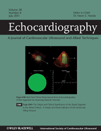Right Atrial Speckle Tracking Analysis as a Novel Noninvasive Method for Pulmonary Hemodynamics Assessment in Patients with Chronic Systolic Heart Failure
Conflict of Interest: None declared.
Abstract
Background: The right atrium (RA) plays multiple roles in the cardiac cycle. The reservoir phase of the RA is a dynamic rather than a static phase of cardiac cycle and RA deformation is dependent on pulmonary pressures exerted on the right ventricle and, therefore, backwards on the RA. The purpose of this study was to assess the accuracy and the clinical applicability of the speckle tracking echocardiography (STE) evaluation of the RA in predicting the invasive systolic pulmonary artery pressure (SPAP) in patients with systolic heart failure (HF) undergoing right heart catheterization (RHC). Methods: Thirty-one hemodynamically stable, in-clinic HF patients who were undergoing RHC were included. Doppler echocardiography and RHC catheterization were simultaneously performed. Echocardiographic measures and STE where obtained as peak atrial longitudinal strain (PALS), RA strain rate, and time to peak longitudinal strain (TPLS). RA PALS was inversely correlated with invasively assessed SPAP (r =–0.81; P < 0.001) while RA strain directly correlated with SPAP (r = 0.82; P < 0.001). RA PALS and strain rate retained this correlation even after nitroprusside challenge test (r =–0.81; P < 0.001 and r = 0.91; P < 0.001, respectively). Area under the curve optimal cutoffs for predicting the SPAP > 50 mmHg were for RA PALS 10.3% (AUC:0.93, sensitivity: 100%, specificity: 78%). Conclusion: RA STE showed a significant correlation with pulmonary pressure. RA assessment with STE can predict pulmonary artery hypertension in HF patients. This result is consistent with nitroprusside challenge test. Although RA STE is not routinely used, its evaluation may implement right heart evaluation in HF patients. (Echocardiography 2011;28:658-664)




